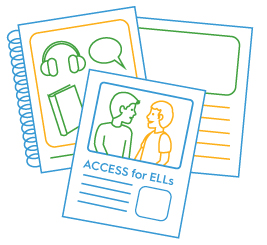Resources/Recursos
Featured Resources



All resources/Todos los recursos
Filter resources by:
Resources/Recursos
Characteristics of English Learners With Significant Cognitive Disabilities: Findings from the Individual Characteristics Questionnaire
This ALTELLA report examines pilot findings from the ALTELLA Individual Characteristics Questionnaire, which surveyed educators about their students. The report explores survey information that may be useful to states in developing accountability policies, alternate academic achievement standards, and other state policies and guidance materials.
Resource Details View Download NowReleased September 2025
Classroom Perspectives on English Learners With Significant Cognitive Disabilities
This ALTELLA report highlights findings from 88 classroom observations and 94 follow-up interviews with educators of these classes. These findings shed light on the classroom practices used to support the English language development of students who are dually identified as English learners and students with significant cognitive disabilities.
Resource Details View Download NowReleased September 2025
ALTELLA Project Individual Characteristics Questionnaire
This Individual Characteristics Questionnaire was developed in 2018 by the ALTELLA project. Anyone can use the ALTELLA Individual Characteristics Questionnaire (fillable PDF) to collect characteristic information on a multilingual learner with a disability.
Note: A slightly different Individual Characteristics Questionnaire is part of the WIDA Alternate ACCESS test materials.
Resource Details View Download NowReleased September 2025
Nonverbal Communication in Diverse Classrooms: Intercultural Competence Considerations for Supporting English Learners With Significant Cognitive Disabilities
Use this ALTELLA Research Brief to learn about nonverbal communication, which is an important component of communication for multilingual learners with significant cognitive disabilities. The brief explores the individual cultural differences in nonverbal communication for these students.
Resource DetailsReleased September 2025
WIDA Self-Paced Workshops Flyer
WIDA offers Professional Learning that you can complete when you want, where you want, and at your own pace. Ready to get started? This resource will show you what offerings are available and how you can access them.
Resource Details View Download NowReleased September 2025
WIDA Speaking Scoring Rubric Grades 1-12
Use this rubric to score speaking responses for WIDA ACCESS tests only.
Note: To score WIDA Screener and the WIDA ACCESS Braille Speaking test, refer to the WIDA Speaking Scoring Scale: Grades 1-12.
Resource Details View Download NowReleased August 2025
WIDA Writing Scoring Rubric Grades 1-12
Use this rubric to score writing responses for WIDA ACCESS tests only.
Note: To score WIDA Screener, refer to the WIDA Writing Scoring Scale: Grades 1-12.
Resource Details View Download NowReleased August 2025
Educator Questions
This resource suggests questions you can use for your ongoing conversations with other educators to help build trust and collaborative relationships with multilingual students, families and communities.
For more context around this resource, please visit the Building Trust in Action Snapshot.
Resource Details View Download NowReleased August 2025
Video: Voices of Families Part I
In this video, multilingual families and their children share about building trust through care, mutual respect and cultural and linguistic humility.
Resource DetailsReleased August 2025
Video: Voices of Families Part II
In this video, multilingual families share about building trust with educators through believing in each other’s skills and knowledge, and showing integrity and follow-through.
Resource DetailsReleased August 2025
Student Questions (multiple languages)
This resource suggests questions you can use for your ongoing conversations with multilingual learners to help build trust and collaborative relationships.
Resource DetailsReleased August 2025
Awareness in Action
This WIDA Snapshot offers an introduction to awareness, one of the six ABCs of Family and Community Engagement. The ABCs of Family and Community Engagement are six key considerations for educators who support multilingual learners and their families and communities.
Resource DetailsReleased August 2025
Advocacy in Action
This WIDA Snapshot offers an introduction to advocacy, one of the six ABCs of Family and Community Engagement. The ABCs of Family and Community Engagement are six key considerations for educators who support multilingual learners and their families and communities.
Resource DetailsReleased August 2025
Building Trust in Action
This WIDA Snapshot offers an introduction to building trust, one of the six ABCs of Family and Community Engagement. The ABCs of Family and Community Engagement are six key considerations for educators who support multilingual learners and their families and communities.
Resource DetailsReleased August 2025
Plan Curriculum, Instruction and Classroom Assessment With the WIDA Language Charts
This WIDA Snapshot provides guidance on how to use the WIDA Language Charts to collaborate and plan instruction.
Resource DetailsReleased August 2025
La pracademia en la práctica: integrando la investigación y la docencia en el salón de clases
Este resumen de investigación explora casos de estudio específicos en relación a la pracademia y como se ve en la práctica. Los casos presentados ilustran que la investigación en el aula es factible y tiene un gran impacto. Los educadores tienen mucho que aportar significativamente a la investigación académica a través de su trabajo. Sin embargo, estos ejemplos también conciencian sobre el hecho de que si bien se trata de educadores y esfuerzos ejemplares es necesario implementar cambios sistémicos para abordar los desafíos que podrá enfrentar el universo de educadores de aula y que no todos los ejemplos tendrán el mismo éxito que los que hemos leído sin los recursos y apoyo necesarios.
Resource DetailsReleased July 2025
Pracademics in Practice: Integrating Research and Teaching in the Classroom
This research brief explores specific case studies on what pracademics looks in practice. The cases presented illustrate that research within the classroom is both feasible and impactful. Educators have a lot to meaningfully contribute to scholarship through their work. However, these examples also raise awareness on the fact that while these are exemplary educators and efforts, there are systemic changes that need to occur to address the challenges that the general educator population could face and that not all examples can be successful if the needed supports are not in place.
Resource DetailsReleased July 2025
WIDA Alternate Screener Accommodations Checklist
This checklist can be used for tracking the accommodations a student receives on WIDA Alternate Screener.
Resource Details View Download NowReleased July 2025
Annual Technical Report for ACCESS for ELLs Paper ELP Test, Series 602, 2023–2024 (redacted version)
ACCESS for ELLs Paper technical reports provide evidence for validity and reliability of ACCESS for ELLs Paper and support intended uses, interpretations, and decision made with the test. This is the redacted report for the 2023-2024 administration of ACCESS for ELLs Paper without item information.
NOTE: Both the View and Download Now links will prompt a download of a zip file that contains three files: Part 1: Executive Summary, Purpose, Design, and Implementation; Part 2: Technical Results; Part 3: References.
Resource Details View Download NowReleased June 2025
Annual Technical Report for ACCESS for ELLs Online ELP Test, Series 602, 2023-2024 (redacted version)
ACCESS for ELLs Online technical reports provide evidence for validity and reliability of ACCESS for ELLs Online and support intended uses, interpretations, and decision made with the test. This is the redacted report for the 2023-2024 administration of ACCESS for ELLs Online without item information.
NOTE: Both the View and Download Now links will prompt a download of a zip file that contains three files: Part 1: Executive Summary, Purpose, Design, and Implementation; Part 2: Technical Results; Part 3: References.
Resource Details View Download NowReleased June 2025




